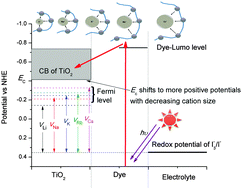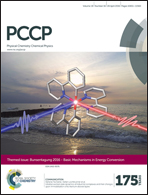Effect of the alkaline cation size on the conductivity in gel polymer electrolytes and their influence on photo electrochemical solar cells
Abstract
The nature and concentration of cationic species in the electrolyte exert a profound influence on the efficiency of nanocrystalline dye-sensitized solar cells (DSSCs). A series of DSSCs based on gel electrolytes containing five alkali iodide salts (LiI, NaI, KI, RbI and CsI) and polyacrylonitrile with plasticizers were fabricated and studied, in order to investigate the dependence of solar cell performance on the cation size. The ionic conductivity of electrolytes with relatively large cations, K+, Rb+ and Cs+, was higher and essentially constant, while for the electrolytes containing the two smaller cations, Na+ and Li+, the conductivity values were lower. The temperature dependence of conductivity in this series appears to follow the Vogel–Tamman–Fulcher equation. The sample containing the smallest cation shows the lowest conductivity and the highest activation energy of ∼36.5 meV, while K+, Rb+ and Cs+ containing samples show an activation energy of ∼30.5 meV. DSSCs based on the gel electrolyte and a TiO2 double layer with the N719 dye exhibited an enhancement in the open circuit voltage with increasing cation size. This can be attributed to the decrease in the recombination rate of electrons and to the conduction band shift resulting from cation adsorption by TiO2. The maximum efficiency value, 3.48%, was obtained for the CsI containing cell. The efficiencies shown in this study are lower compared to values reported in the literature, and this can be attributed to the use of a single salt and the absence of other additives, since the focus of the present study was to analyze the cation effect. The highest short circuit current density of 9.43 mA cm−2 was shown by the RbI containing cell. The enhancement of the solar cell performance with increasing size of the cation is discussed in terms of the effect of the cations on the TiO2 anode and ion transport in the electrolyte. In liquid electrolyte based DSSCs, the short circuit current density has been reported to decrease with the increasing size of the cation. However, in this work, it follows an opposite trend highlighting a major difference between liquid and quasi-solid electrolytes on the solar cell performance.


 Please wait while we load your content...
Please wait while we load your content...